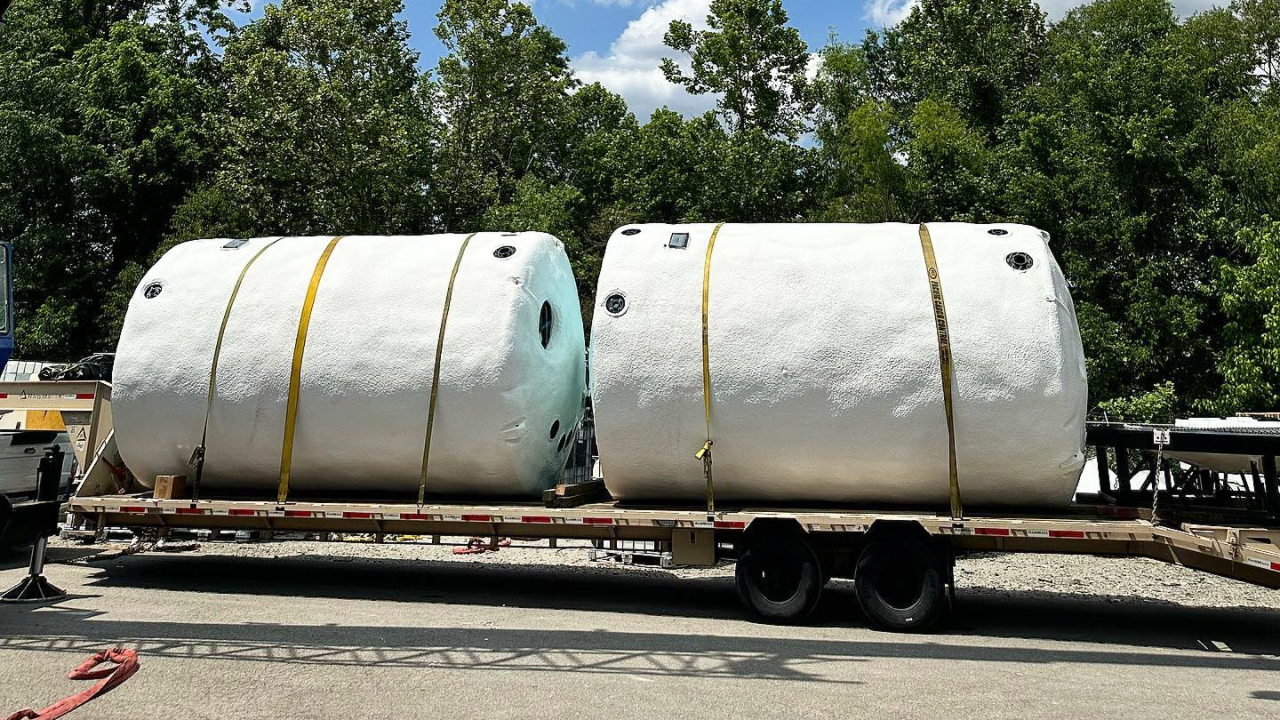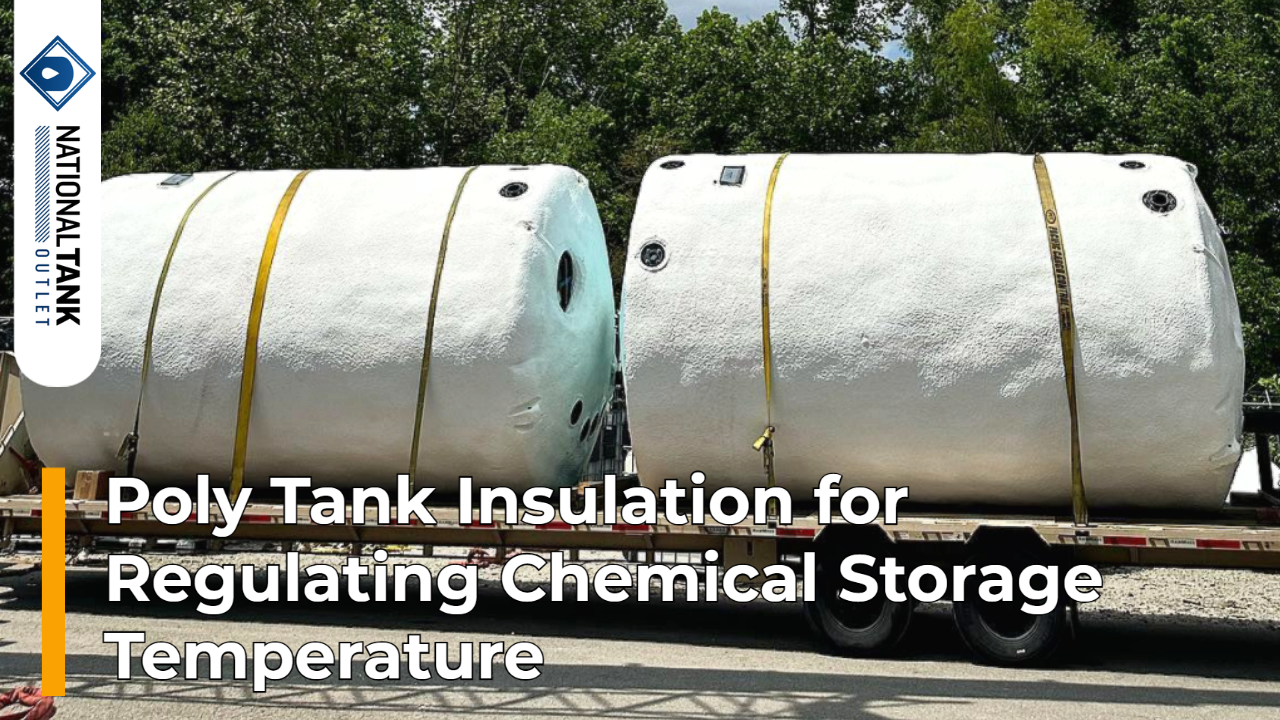
Industry professionals and businesses who use bulk volumes of materials such as liquid chemicals, know that regulating storage temperature is often either a requirement or a high-value benefit to the operation. Chemicals and solutions have a range of material-specific properties that often have to be accommodated for in long term storage, refilling, and use. Examples of such chemical-specific properties include freezing, boiling, crystallization, precipitation, degradation, breakdown, evaporation, off-gassing, and vapor generation.
Poly tank insulation uses a thermal insulation material to help protect against and, in some cases, prevent these concerns in bulk storage and industrial tanks.
What is Poly Tank Insulation
Poly tank insulation is a thermal insulation coating applied to the exterior of a polyethylene storage tank container product to help negate the effects of environmental factors such as temperature conditions, fluctuations, and sunlight exposure to maintain an overall desired storage temperature. The thermal insulation material recommended and used by our company is a polyurethane spray foam. Polyurethane is a synthetic material chosen for its ease of application, durability, specific properties, and reliable insulation resistance values.
During application, the polyurethane insulation is sprayed over the entire exposed surface of a storage tank to a 2” nominal thickness. When fully applied and ready, the insulation protects the storage tank from the effects of direct sunlight, both UV exposure and warming, and ambient temperature changes to protect the internal temperature conditions of the chemical or liquid being stored.
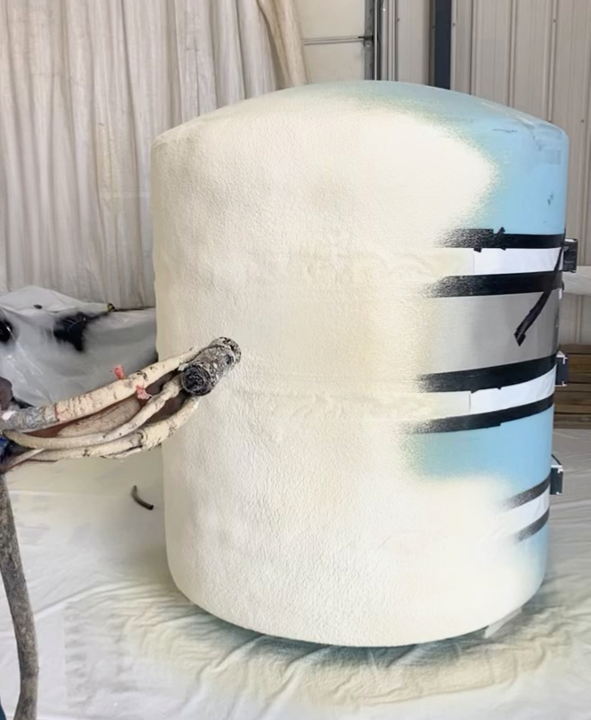
After polyurethane insulating and cure time, two coats of a waterproof latex mastic is applied over the entire surface. The mastic coating seals the polyurethane insulation, shielding and protecting it from the environment and weather.
Properties of Polyurethane Tank Insulation
Polyurethane is light in weight, fire resistant, and provides appreciable thermal resistance. The specific formulation of polyurethane spray foam we use has a density of 2.0 to 3.0 pounds per cubic foot (lbs/ft3) and a measure of thermal resistance, R-value, of 8.33 per inch. This is a more heavy-duty formulation and on a grade above many competitor products, meaning a more reliable, more effectively insulated storage tank.
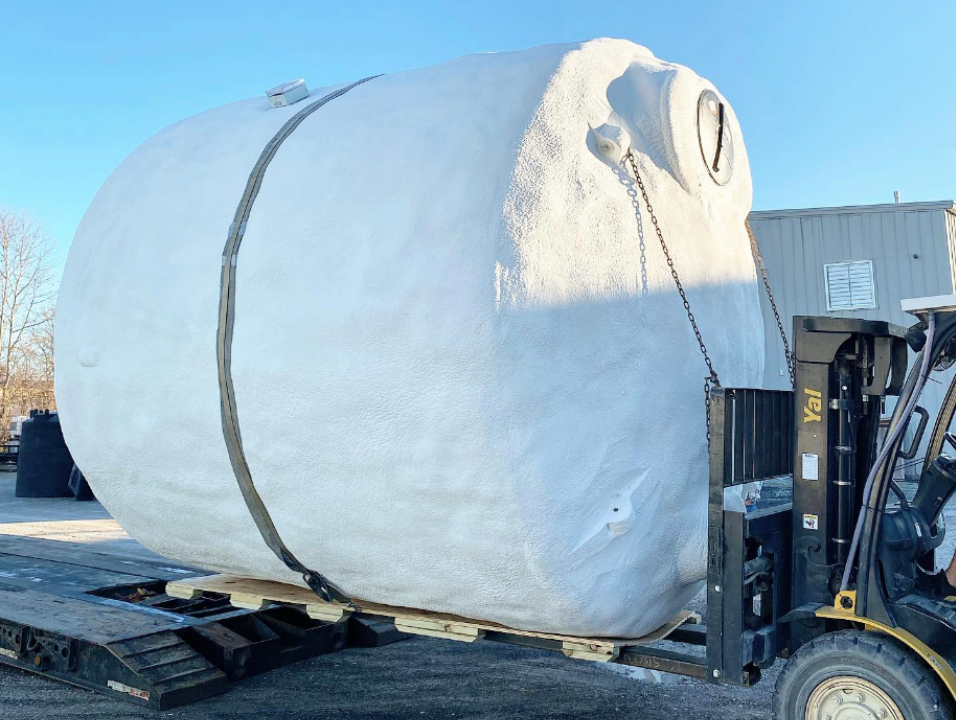
When and Why to Use Poly Tank Insulation
In short, there are 5 main scenarios that relate to when and why to use poly tank insulation. These include: (1) when the application requires a set operation temperature for the liquid material being stored, (2) when the storage material is temperature sensitive, (3) when the material is sensitive to sunlight UV exposure, (4) when storage is in an extreme heat environment, and (5) when storage is in an extreme cold environment.
These scenarios will be looked at in more detail below.
1. When an Application Requires a Set Operation Temperature
Many chemicals, liquids, and product materials used across industrial, commercial, and manufacturing applications often require a set operation temperature. The operation temperature can be required to facilitate mixing, drive a chemical reaction, promote viscosity or fluidity, and/or allow product formulation.
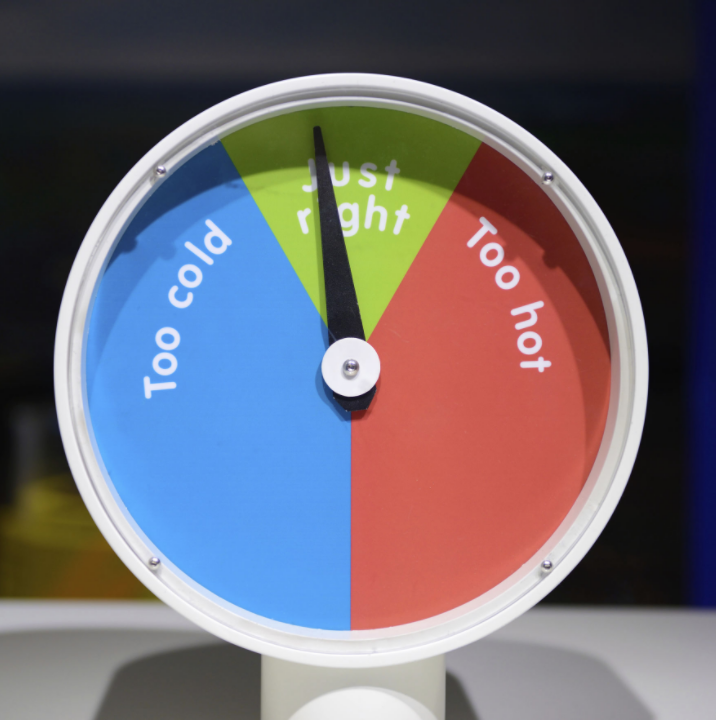
Insulating a storage tank will help maintain the desired operation temperature for liquid use by increasing the solution and storage container product’s resistance to temperature fluctuations.
2. When the Stored Material is Temperature Sensitive
Chemicals, mixtures, and water are all sensitive to select temperature ranges in respect to the liquid’s freezing point, boiling point, rate of evaporation, off-gassing, and solubility.
Concentrated sodium hydroxide, 50% NaOH, is an excellent example of a chemical that is sensitive to freezing and solubility concerns where temperatures have to be kept above 52°F to prevent freezing and/or crystallization of NaOH from solution.

Sulfuric acid and hydrochloric acid are great examples where elevated temperatures and solution warming, such as from sunlight exposure, should be avoided to prevent off-gassing and the generation of chemical vapors.
Poly tank insulation will help protect a stored material from temperature ranges that can affect usability or stability and result in these undesired working conditions.
3. When the Stored Material is UV Sensitive
Certain chemicals are sensitive to reactions and interactions, such as breakdown degradation, when directly exposed to ultraviolet (UV) radiation energy from the sun. Sodium hypochlorite, bleach, and diesel exhaust fluid (DEF) are examples of common materials frequently stored in bulk that are UV sensitive and can directly benefit from a polyurethane insulated storage tank.

Polyurethane insulation provides an additional layer of protection, shielding the tank against UV impact and preventing, or severely reducing, the extent of UV penetration that can result in solution exposure and undesirable chemical reactions.
4. For Hot Environments
Company bulk liquid solutions are often stored outside and are therefore exposed to ambient temperature conditions. In the United States, many regions experience elevated seasonal summer temperatures that can be potentially damaging to the stored material or to the polyethylene storage tank itself.

For scenarios with hot environments where high temperature influences must be avoided to protect the quality or usability of the stored liquid, poly tank insulation provides a reliable and successful solution.
5. For Cold Environments
For outdoor liquid storage environments located in more northern regions and/or with extended, cold winter seasons, freezing can become a concern. There are many concentrated and saturated chemical solutions with elevated freezing points and therefore, freezing must be avoided to maintain business operations and in some cases, prevent chemical damage.

Polyurethane insulation, especially when used together with heat tracing equipment, can eliminate the concern of product freezing and the interruption of onsite applications.
Common Storage Materials for Insulated Poly Tanks
The following is a list of common storage materials where insulated poly tanks are used for temperature maintenance and protection.
- Aluminum Sulfate (Alum, Al2(SO4)3)
- Ferrous Sulfate (Iron (II) Sulfate)
- Hydrochloric Acid (Muriatic Acid, HCl)
- Hydrofluosilicic Acid (Fluorosilicic Acid, H2SiF6)
- Potassium Hydroxide (Potash, KOH)
- Sodium Aluminate (Sodium Aluminum Oxide, NaAlO2)
- Sodium Bisulfate (Sodium Hydrogen Sulfate, NaHSO4)
- Sodium Hydroxide (Caustic, Lye, NaOH)
- Sodium Hypochlorite (Bleach, NaOCl)
- Sodium Permanganate (Sodium Manganate (VII), NaMnO4)
- Sulfuric Acid (Dihydrogen Sulfate, Battery Acid, H2SO4)
- Surfactants
- Urea Solutions (Carbamide, CH4N2O)
- Water
When Can Poly Tank Insulation Be Used
Polyurethane storage tank insulation is primarily used on polyethylene plastic containers. Insulation is most often added to vertical storage tank model products. This tank model type includes vertical water tanks, industrial storage tanks, chemical storage tanks, and double walled tanks. Poly tank insulation can also be used and applied to cone bottom tanks, doorway tanks, leg tanks, open top tanks, and utility tanks.
In general, poly tank insulation can be used whenever the afforded thermal resistance factor provides sufficient temperature maintenance for the application and liquid being stored. When insulation alone is not enough, a custom poly tank solution can be used together with a heat trace system to ensure the optimum or required temperature is maintained, (more on this in the next section).
Residential
In residential, consumer applications, poly tank insulation can be used to help keep a water tank cool in the summer and/or from freezing in the winter.
Agriculture
In agriculture applications, poly tank insulation is perfect for livestock watering, irrigation, fertigation, and chemical storage uses to protect farm liquids, products, and materials from excess heating or freezing temperatures.
Outdoors / Indoors
Poly tank insulation can be used both outdoors and indoors. While outdoor applications are the primary setting for tank insulation, indoor setups can also be used to help regulate and maintain highly sensitive solutions, chemicals with high freezing points, or liquids with a high temperature of precipitation.
Additional Uses
Polyurethane spray foam tank insulation use is not exclusive to polyethylene plastic storage tanks and can also be used on container products made from steel or stainless steel. Due to the spray foam properties and method of application, polyurethane insulation helps to eliminate any concern with moisture beneath the insulating cover, protecting the tank from and preventing any concerns of corrosion should the insulation be used on metal storage tanks.
Heat Tracing | A Complement to Poly Tank Insulation
Heat tracing is an equipment upgrade and customization option available for polyethylene storage tanks and serves as the ultimate complement to poly tank insulation for liquid chemical temperature regulation. Heat trace equipment, when used with insulation, provides one of the best, most reliable options available for keeping company chemicals at the temperatures necessary for stability, security, and use.
The bottom line: when needing to protect a company stock solution and maintain a consistent storage temperature, use an insulated poly tank fitted with a heat tracing system. Heat trace systems are custom engineered to meet the specification requirements in terms of the application, desired temperature, chemical material to be stored, and the total volume.
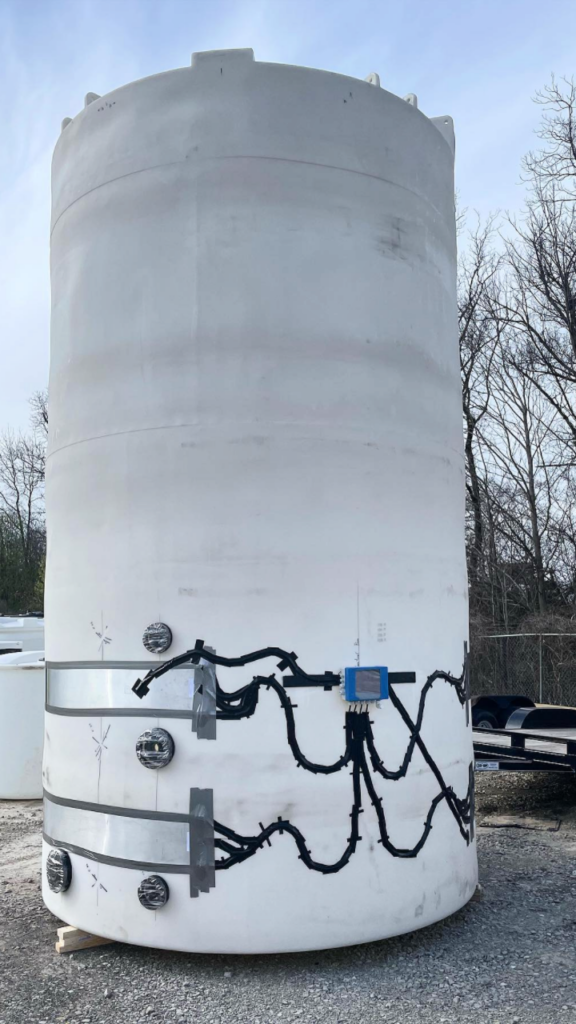
A complete heat tracing and insulation system will feature an electronic control box, thermostat, and heat trace panels all contained beneath 2” thick polyurethane foam with latex mastic weatherproof coating. For more on the heat trace equipment and customization option, see our product details page or our article Heat Tracing: the Ultimate in Storage Temperature Maintenance.
Takeaway | Poly Tank Insulation for Regulating Chemical Storage Temperature
Polyurethane tank insulation is a popular option when needing to regulate chemical storage temperature, protect the stock solution integrity, and ensure continued business operations. Bulk storage tanks can be insulated with a 2” thick polyurethane foam that provides an 8.33 lbs/in R-value insulation rating that is then sealed with a waterproof, mastic coating. Various storage tank products can be customized with polyurethane insulation to meet the needs and specifications of an application. Heat tracing equipment is often used with insulation to provide a complete solution to temperature protection and regulation.
As America’s Liquid Tank Superstore, we are a nationwide leader in storage container products, accessories, options, and customization such as insulation and heat tracing. To request a quote or learn more about our custom tank solutions, click here. If you have further questions or require assistance, contact us, our professional support experts are always ready to help.
